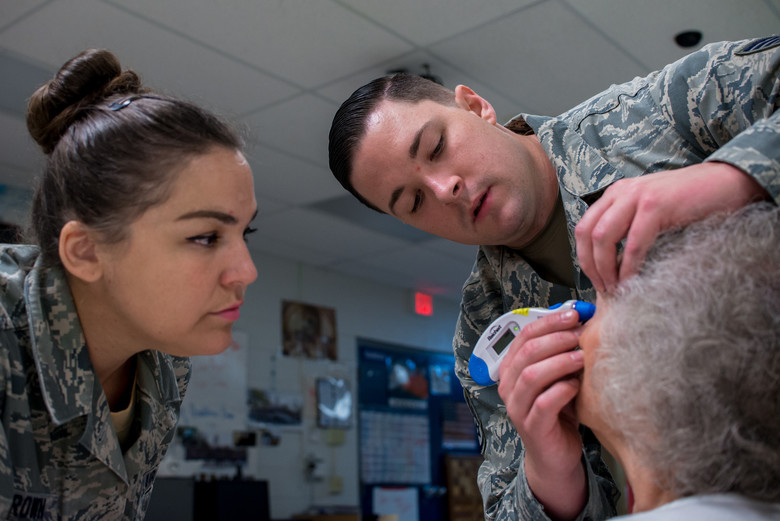 Master Sgt. Julie Brown and Staff Sgt. Michael Pate, both medical technicians from the Texas Air National Guard’s 136th Medical Group, test a patient's eye pressure June 21, 2018, at one of four health-care clinics in Eastern Kentucky. Members of the Air National Guard and U.S. Navy Reserve are conducting Operation Bobcat, which provides military health-care troops with critical training in logistics and field operations while providing lasting benefits to the civilian community. The clinics offer no-cost medical screenings; dental cleanings, fillings and extractions; vision exams and no-cost eyeglasses. (U.S. Air National Guard photo by Tech. Sgt. Lynn Means)
Master Sgt. Julie Brown and Staff Sgt. Michael Pate, both medical technicians from the Texas Air National Guard’s 136th Medical Group, test a patient's eye pressure June 21, 2018, at one of four health-care clinics in Eastern Kentucky. Members of the Air National Guard and U.S. Navy Reserve are conducting Operation Bobcat, which provides military health-care troops with critical training in logistics and field operations while providing lasting benefits to the civilian community. The clinics offer no-cost medical screenings; dental cleanings, fillings and extractions; vision exams and no-cost eyeglasses. (U.S. Air National Guard photo by Tech. Sgt. Lynn Means)
Story By: Tech. Sgt. Lynn M. Means
136th Airlift Wing
BEATTYVILLE, Ky. --
Members of the 136th Medical Group are part of a joint effort to provide no-cost health-care services to residents in Eastern Kentucky June 15-24, 2018. The operation allows units from the Air National Guard and U.S. Navy Reserve to provide members valuable expeditionary training while serving a community with limited access to health-care services.
Operation Bobcat provides patients with medical screenings and non-emergent medical care, as well as connections to local resources. Patients can also receive a dental examination, where any extractions and fillings can be done on the spot. Those seeking vision services receive an optical exam and a free pair of eyeglasses within 48 hours.
Four areas in Eastern Kentucky were chosen for this Innovative Readiness Training program due to their greater need of medical service, said Lt. Col. Patricia W. Adams, an optometrist with the 123rd Airlift Wing and the officer in charge of the Lee County site.
“A lot of people are coming in pain,” Adams said. “Even if they have medical insurance, a lot of them don’t have dental or vision insurance, so this area is underinsured and it’s underserved. There are not very many providers here. Access to care is an issue.”
Some patients arrived on foot, having walked several miles and hours to receive care. Others were given a ride by friends and neighbors. Many had not been able to receive this kind of care in years. The ability to serve these residents gives purpose to the mission.
“We had one gentleman that was confined to a wheelchair and has been for a long time,” said Maj. Brett Ringger, an optometrist with the 136th Medical Group. “He has so many physical limitations that he could not go to a regular optometrist’s office. He could not extend his legs at all, he had his knees up by his chin, his feet were actually on the seat of the wheelchair. So he couldn’t fit in the chair, and they didn’t have wheelchair-accessible equipment like we do. But with our portable, deployable kit, we were able to put that phoroptor right in front of him, behind his knees and in front of his face, and we were able to prescribe his glasses for the first time in forever. He was so excited he came and gave us a little pin. He was real excited.
“It’s great to be able to work with the deployable equipment,” said Ringger. “It’s a little different than the equipment in our clinic, so it’s nice to come into a situation, set up a clinic just like we would anywhere for a natural disaster, or something overseas, and it’s the same type of services that we can provide there. It’s great training, I love being able to train and take care of people as well.”
For some members, this is their first taste of a deployed environment.
“I have never been deployed or on an IRT before,” said Airman 1st Class Ashley Sharp, a bioenvironmental engineer with the 136th Medical Group. “I’ve got some training here that I don’t usually get back home. I’ve taken radiation surveys on the dental equipment to make sure personnel are not receiving high-radiation doses, I’ve learned several admin roles, run equipment and supplies to sites, and provided safety briefings. I like being able to help out with the communities here and I think it’s really cool that we’re getting training experience but also helping out humanitarian-wise.”
Operation Bobcat is part of the Innovative Readiness Training Program, which facilitates enhanced military skills training while also providing lasting benefits to a community in need. Part of that training include the logistics of getting materials and personnel set up in a remote environment. In the span of one day, 200 Air National Guardsmen and U.S. Navy Reservists set up four sites in Jackson, Irvine, Beattyville and Booneville.
“We’re in the mountains, none of our cell phones work,” said Adams. “It has created a great training opportunity all around. The training also includes military movement and then logistical movement. We had one day to put a clinic together, there was 30 tons of equipment that arrived.”
Through Operation Bobcat, the clinics were able to serve 2,662 residents with 11,275 medical, dental, and optometry procedures, including 1,457 pairs of prescription eyeglasses. The economic impact to the community was more than $1 million ($1,003,688).